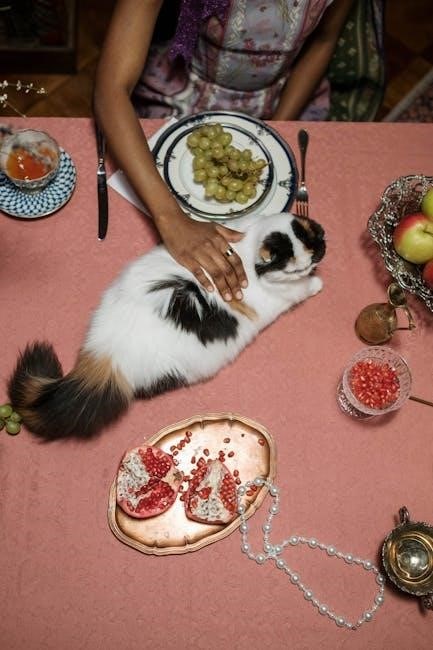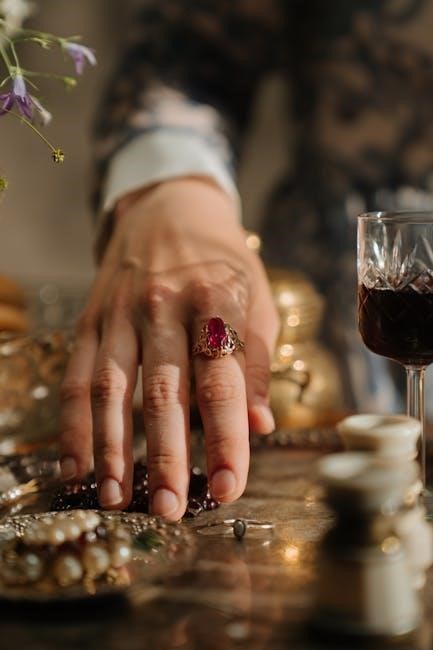pearl size guide
Pearls have captivated humanity for centuries, cherished for their natural beauty and rarity. Formed within mollusks, their size and luster significantly influence value. This guide explores size impact on pearl selection and appreciation, aiding informed choices.
1.1 What Are Pearls?
Pearls are natural gems produced within the soft tissue of mollusks, such as oysters and mussels, as a defense mechanism against irritants like sand or parasites. Composed of nacre, a substance secreted by the mollusk, pearls can form naturally or through cultivation. Their beauty, luster, and rarity make them highly valued in jewelry and culture. Pearl size, shape, and surface quality are key factors in determining their worth, with larger, rounder pearls typically being more prized. Understanding pearls begins with appreciating their unique formation and characteristics.
1.2 The Importance of Pearl Size
Pearl size significantly impacts their value, beauty, and versatility in jewelry. Larger pearls are rarer and often more valuable due to the longer time required for formation. Size influences how pearls appear in settings, with larger ones making bold statements and smaller ones offering delicate elegance. Understanding pearl size helps in selecting pieces that align with personal style and budget, while also appreciating the natural factors that contribute to their rarity and allure. Size is a fundamental aspect of evaluating and appreciating pearls.
Types of Pearls
Pearls come in various types, each with unique characteristics. Akoya, Tahitian, South Sea, and Freshwater pearls differ in size, color, and luster, influencing their value and appeal.
2.1 Akoya Pearls
Akoya pearls are renowned for their exceptional luster and spherical shape, typically ranging from 3mm to 10mm in size. Originating primarily from Japan and China, they are the most widely cultivated pearls, prized for their white or cream hues. Their smaller size and high quality make them ideal for necklaces and earrings, blending elegance with affordability. Akoya pearls are a classic choice, reflecting timeless beauty and sophistication in jewelry designs.
2.2 Tahitian Pearls
Tahitian pearls, native to French Polynesia, are celebrated for their large size and exotic dark hues. Typically ranging from 8mm to 15mm, they are cultivated in the black-lipped oyster. Known for their iridescent colors, including peacock, aubergine, and charcoal, these pearls exude luxury. Their substantial size and unique tones make them ideal for statement jewelry. Tahitian pearls are highly prized for their rarity, luster, and surface quality, offering a dramatic and elegant choice for discerning collectors and jewelry enthusiasts alike.
2.3 South Sea Pearls
South Sea pearls are among the largest and most luxurious, primarily farmed in Australia, Indonesia, and the Philippines. Produced by the Pinctada maxima oyster, they typically range from 8mm to over 20mm, making them highly sought after for their size and luster. Their thick nacre layers contribute to exceptional durability. While their value is influenced by luster, size remains a critical factor, with larger pearls being exceedingly rare and valuable. South Sea pearls are a symbol of opulence and timeless elegance in jewelry design.
2.4 Freshwater Pearls
Freshwater pearls are known for their affordability and diverse size range, typically measuring between 2mm and 15mm. Produced by freshwater mussels, primarily in China, they are more accessible than saltwater varieties. Their size variation is influenced by factors like water conditions and mussel species. While smaller sizes are common, larger freshwater pearls, though rare, can achieve significant value. These pearls offer a versatile choice for jewelry, balancing beauty and budget, making them a popular option for those seeking elegant yet affordable gemstones.
2.5 Cultured vs. Natural Pearls
Cultured pearls are far more common than natural pearls, as they are cultivated in controlled environments. Natural pearls form spontaneously in wild mollusks, making them exceedingly rare and valuable. While natural pearls are typically smaller, cultured pearls can achieve larger sizes due to farming techniques. Both types are prized for their beauty, but cultured pearls are more accessible and affordable; Understanding the difference helps buyers appreciate the craftsmanship behind cultured pearls and the rarity of natural ones, influencing size preferences and purchasing decisions.

Measuring Pearl Size
Pearl size is measured using precise tools like calipers, focusing on diameter and depth in millimeters. Accurate sizing is crucial for determining value and guiding buyers.
3.1 How Pearls Are Sized
Pearls are sized using precision tools like calipers or sizing gauges, measuring their diameter and depth in millimeters. Clean, dry pearls are placed on a calibrated surface, ensuring accurate readings. Multiple measurements are taken to account for irregular shapes. The process emphasizes consistency and expertise, as sizing impacts value and classification. Standardized methods ensure reliability across the industry, helping buyers compare pearls effectively. This meticulous process guarantees that each pearl’s size is recorded precisely, reflecting its true dimensions and quality.
3.2 Standard Pearl Size Charts
Standard pearl size charts provide a consistent reference for measuring and categorizing pearls, typically ranging from 1mm to 20mm in diameter. These charts help jewelers and buyers classify pearls accurately, ensuring uniformity in pricing and comparisons. While slight variations exist depending on pearl type, most charts follow a widely accepted scale. This standardized approach simplifies the process of evaluating pearl quality and value, allowing for fair assessments and informed purchasing decisions.
3.3 Millimeter vs. Inch Measurements
Pearl sizing is typically measured in millimeters, as this provides precise and consistent sizing. Inches are rarely used, but understanding the conversion (1 inch = 25.4 millimeters) can be helpful for context. Millimeter measurements are preferred due to their accuracy and relevance in determining pearl value. This method ensures clarity when comparing sizes across different pearl types, making it easier to assess quality and price. Standardizing measurements in millimeters promotes fairness and transparency in the pearl market.

Factors Influencing Pearl Size
Pearl size is influenced by pearl type, oyster size, and environmental conditions. Larger oysters generally produce bigger pearls, while water depth and nutrition also play significant roles.
4.1 Pearl Type and Size Range
Different pearl types vary in size due to their unique biology and cultivation methods. Akoya pearls typically range from 7-9.5mm, while Tahitian pearls are larger, often 9-14mm. South Sea pearls are the largest, reaching up to 20mm. Freshwater pearls are usually smaller, between 6-12mm, with some exceptions. The mollusk species, environmental conditions, and farming practices significantly influence these size ranges, making each pearl type distinct in its growth potential. Understanding these size ranges helps buyers align expectations with the pearl type they desire.
4.2 The Role of the Oyster
The oyster plays a pivotal role in determining pearl size. Larger oysters naturally produce bigger pearls, while smaller mollusks yield smaller gems. The oyster’s health and species also influence size, as healthier mollusks can nurture larger pearls. Additionally, the nucleus size inserted during culturing affects the final pearl dimensions. Species-specific traits, such as the size of the inner shell, further shape the pearl’s growth potential. Understanding the oyster’s role highlights the intricate biology behind pearl size variation and its impact on the final product’s quality and value.
4.3 Environmental Factors
Environmental factors significantly influence pearl size. Water temperature, salinity, and nutrient availability affect oyster metabolism, which impacts pearl growth. Optimal conditions promote larger pearls, while stressors like pollution or extreme temperatures can stunt growth. Climate change also plays a role, altering habitats and affecting pearl size. Additionally, the availability of food sources and the presence of predators influence oyster health, indirectly impacting pearl development. These environmental elements highlight the delicate balance required for producing high-quality, larger pearls.

Pearl Size and Value
Pearl size significantly impacts value, as larger pearls are rarer and command higher prices, enhancing their beauty and investment potential.
5.1 How Size Affects Price
Pearl size directly influences price due to rarity and growth time. Larger pearls, especially South Sea and Tahitian, are highly sought after, driving up their value significantly. Smaller pearls, while still precious, are more common and thus less expensive. The relationship between size and price is not linear; as pearls increase in diameter, their cost rises exponentially. This reflects the rarity of larger specimens and the extended time required for their cultivation. High demand for oversized pearls further amplifies their market value.
5.2 Rarity and Demand
Rarity significantly impacts pearl value, as larger, high-quality pearls are harder to cultivate. Demand for specific sizes and types, such as oversized South Sea pearls, drives up prices. Market trends show that rare pearls, particularly those with exceptional luster and surface quality, command premium prices due to their scarcity. Cultural preferences and fashion trends also influence demand, making certain pearl sizes more desirable. As a result, rarity and demand are critical factors in determining the final price of pearls in the marketplace.
5.3 Comparing Sizes Across Pearl Types
Pearl sizes vary significantly across types, influencing their value and appeal. Akoya pearls typically range from 7-9.5mm, while Tahitian pearls are larger, often 9-14mm. South Sea pearls are the largest, reaching up to 20mm, making them highly sought after. Freshwater pearls, though smaller (6-12mm), offer versatility. Comparing sizes helps buyers understand each type’s unique characteristics and market value, ensuring they choose pearls that align with their preferences and budget.
Choosing the Right Pearl Size
Selecting the ideal pearl size involves balancing budget, style, and occasion. Consider personal preferences and the intended use to find the perfect fit for any setting.
6.1 Consider Your Budget
Your budget is a critical factor in selecting the right pearl size. Pearl prices increase significantly with size, as larger pearls are rarer and more valuable. While smaller pearls may be more affordable, they can still offer stunning beauty. Set a clear budget to narrow your options and focus on the best value within your range. Remember, larger pearls aren’t always necessary; smaller, high-quality pearls can be just as impactful. Balance size with other factors like luster and surface quality to make the most of your investment.
6.2 Personal Style and Preference
Personal style plays a significant role in choosing pearl size. Consider your wardrobe, lifestyle, and jewelry preferences. Larger pearls suit bold, statement-making styles, while smaller pearls complement minimalist or delicate designs. Face shape and body proportions also matter; petite individuals may prefer smaller pearls, while taller people can carry larger sizes. Think about the occasion—everyday wear vs. formal events—and how pearls will enhance your look. Ultimately, choose a size that reflects your personality and complements your natural elegance, ensuring a timeless and flattering appearance.
6.3 The Occasion or Use
The occasion greatly influences pearl size selection. For formal events, larger pearls create a dramatic, luxurious look, while smaller pearls are ideal for everyday wear. Consider the jewelry type—necklaces, earrings, or rings—and how they’ll be worn. Statement pieces, like chokers, often feature larger pearls, whereas delicate earrings may use smaller ones. Matching pearl size to the event ensures they enhance the overall aesthetic, making them appropriate for both casual and sophisticated settings. This balance ensures pearls complement the occasion perfectly, adding elegance without overpowering.

Pearl Size Chart
A pearl size chart organizes sizes from small (around 5mm) to large (18mm+). It categorizes pearls into common ranges, providing a visual guide for understanding size variations.
7.1 Common Pearl Sizes
Common pearl sizes range from 5mm to 18mm in diameter. Small pearls (5-7mm) are often used in delicate jewelry, while medium (8-10mm) and large (11-13mm) pearls are popular for classic designs. Extra-large pearls (14-18mm) are rare and highly valued. Akoya pearls typically fall within 7-10mm, while South Sea pearls often reach larger sizes. Size preferences vary by culture, with smaller pearls favored in some regions for everyday wear. This range allows buyers to choose pearls that suit their style, budget, and desired impact.
7.2 Size Gradations
Pearl size gradations are standardized to help buyers understand and compare sizes. Gradations typically range from 5mm to 18mm, with increments of 0.5mm. Small pearls (5-7mm) are delicate, while medium (8-10mm) and large (11-13mm) pearls are more versatile. Extra-large pearls (14mm+) are rare and luxurious. Gradations ensure consistency, allowing consumers to choose pearls that align with their preferences and jewelry settings. This system also helps in determining value, as larger pearls are generally more sought after and expensive.
7.3 Visual Guide to Pearl Sizes
A visual guide to pearl sizes helps buyers compare and understand size differences. Diagrams often show pearls side by side, highlighting their diameter in millimeters. Images of pearls in jewelry settings, like necklaces or earrings, provide real-world context. This guide also includes measurements in inches for easier comprehension. Visual comparisons make it easier to discern subtle size variations, aiding in selecting the perfect pearls for desired jewelry pieces. Such guides are essential for making informed decisions, especially when purchasing online.

Pearl Jewelry and Size
Pearl size significantly impacts jewelry design. Necklaces often feature graduated sizes for visual appeal. Earrings and pendants typically use smaller pearls, while rings and bracelets may showcase larger ones. Proper sizing ensures a balanced, elegant look, enhancing both the jewelry and the wearer. Understanding size proportions is key to creating timeless, sophisticated pieces. This guide helps match pearl sizes to jewelry styles for optimal aesthetic and functional results.
8.1 Necklace Length and Pearl Size
Necklace length and pearl size are closely intertwined. A classic 16-18 inch strand complements most necklines, with medium-sized pearls (8-10mm) offering timeless elegance. Longer necklaces (20-24 inches) pair well with smaller pearls (7-9mm), creating a delicate appearance. Conversely, shorter necklaces (14-16 inches) highlight larger pearls (10-12mm), drawing attention to the neckline. Layering necklaces of varying lengths and pearl sizes adds versatility to outfits. Consider skin tone and personal style when selecting—cool tones may favor white pearls, while warmer tones suit golden hues. Balancing length and size ensures a polished, sophisticated look.
8.2 Earrings and Pendant Sizes
Pearl size significantly impacts the elegance of earrings and pendants. Smaller pearls (6-8mm) are ideal for delicate studs or drops, offering a subtle, sophisticated look. Larger pearls (9-12mm) make a bold statement, often used in statement pieces or solitaire pendants. Consider face shape and personal style—oval faces may favor elongated drops, while round faces suit round or button earrings. Pendant length should complement the chain, with smaller pearls pairing well with shorter chains and larger pearls with longer ones. Balancing size ensures a harmonious design tailored to individual taste.
8.3 Ring and Bracelet Sizes
Pearl size plays a crucial role in rings and bracelets, balancing aesthetics and comfort. Rings often feature smaller pearls (6-9mm), as larger sizes may overwhelm the hand. Bracelets typically use a mix of sizes for visual interest, though uniform sizing (8-10mm) creates a sleek, polished look. Consider the pearl type—Akoya and freshwater pearls are popular for rings, while South Sea pearls add luxury to bracelets. Durability is key, as pearls in rings and bracelets are more exposed to wear. Choose sizes that complement the design and intended use, ensuring a timeless appeal.

Care and Maintenance
Pearls require gentle care to preserve their luster and durability. Store them separately to avoid scratching, clean with a soft cloth, and avoid harsh chemicals or extreme temperatures.
9.1 Storing Pearls Properly
Pearls should be stored in a cool, dry place away from direct sunlight and humidity. Use a soft, padded pouch or jewelry box to prevent scratching. Avoid storing pearls in plastic, as this can cause them to dry out. Separate pearls from other jewelry to protect them from damage. For necklaces, hang them to maintain their shape. Cleaning before storage is essential to remove dirt or oils that might harm the pearls over time. Proper storage ensures your pearls remain lustrous and intact for years.
9.2 Cleaning Pearls Safely
Pearls are delicate and require gentle care to maintain their luster. Avoid using harsh chemicals, abrasive materials, or extreme temperatures, as these can damage the nacre. To clean pearls, use a soft, dry cloth to wipe away dirt or oils. For more thorough cleaning, dampen a cloth with mild soap and water, then gently rub the pearls. Avoid submerging pearls in water for extended periods. Never use ultrasonic cleaners or harsh jewelry cleaners, as they can harm the pearl’s surface. Regular, gentle cleaning preserves their beauty and longevity.
9.4 Avoiding Damage to Pearls
Pearls require gentle handling to prevent damage. Avoid exposure to harsh chemicals, extreme temperatures, or direct sunlight, as these can dull their luster. Store pearls separately in a soft pouch or jewelry box to prevent scratching; Remove pearl jewelry before swimming or engaging in strenuous activities. Avoid stacking pearl necklaces or bracelets, as friction can cause wear. Regular inspections can help detect and address issues early, ensuring your pearls remain pristine for years.
Common Mistakes to Avoid
Common mistakes include improper storage, exposure to harsh chemicals, and not obtaining appraisals. Avoid ignoring surface quality and luster, as these impact value. Prioritize care and authentication.
10.1 Buying Without Certification
One common mistake is purchasing pearls without proper certification. This can lead to uncertainty about quality, authenticity, and size. Certified pearls ensure they meet industry standards, providing clarity on their origin and value. Without certification, buyers risk acquiring lower-quality or misidentified pearls. Always insist on documentation from reputable sources, such as the Gemological Institute of America (GIA) or similar organizations. This guarantees transparency and protects your investment. Additionally, third-party appraisals can verify pearl characteristics, ensuring you make an informed purchase.
10.2 Ignoring Luster and Surface Quality
Overlooking luster and surface quality is a critical mistake when buying pearls. Luster refers to the pearl’s shine and depth, while surface quality assesses blemishes or imperfections. High luster enhances beauty, and flawless surfaces are rare. Ignoring these aspects can lead to purchasing pearls of lower value or durability. Always inspect pearls under good lighting and use a jeweler’s loupe to examine their surface. Prioritize luster and surface quality to ensure you’re investing in pearls that retain their beauty and value over time.
10.3 Misjudging Size for Settings
Misjudging pearl size for specific jewelry settings can lead to poor fit and aesthetics. Pearls that are too large may overwhelm delicate features, while small pearls might get lost in bold designs. Consider the type of jewelry—necklaces, earrings, or rings—and the wearer’s physical characteristics, such as neck size or earlobe proportions. Ensure pearls complement the setting without appearing disproportionate. Consulting a jeweler can help match pearl size to the intended design, ensuring a balanced and visually appealing result that enhances both the pearls and the wearer. Proper sizing is key to timeless elegance.

Pearl Size FAQs
This section addresses common questions about pearl size, helping buyers understand key factors like average sizes, value, and measurement methods, ensuring informed decisions for various jewelry needs.
11.1 What Is the Average Pearl Size?
Pearl sizes vary significantly depending on the type. Akoya pearls typically range from 6 to 9 millimeters, while Tahitian and South Sea pearls can reach 10-18 millimeters. Freshwater pearls are usually smaller, averaging 6-8 millimeters. The average size for most pearls falls between 7-10 millimeters, though larger sizes are rarer and more valuable. Understanding these averages helps buyers set realistic expectations when selecting pearls for jewelry or collections, ensuring they align with personal preferences and budget constraints.
11.2 Are Larger Pearls Always More Valuable?
Larger pearls are often more valuable due to their rarity, but size alone doesn’t guarantee higher value. Factors like luster, surface quality, color, and type play significant roles. For example, a smaller pearl with exceptional luster and minimal imperfections may be more valuable than a larger pearl with dullness or flaws. Market demand also influences value, as certain pearl types or sizes are more sought after. Ultimately, value is determined by a combination of size, quality, and rarity, not size alone.
11.3 How Do I Measure My Pearl?
To measure your pearl, use a digital caliper to determine its diameter in millimeters. Gently place the pearl on a flat surface and open the caliper arms to surround it. Record the measurement at the widest point. For irregular shapes, take the average of multiple measurements. Pearls are typically sized in 0.5mm increments. Comparing your measurement to a standard pearl size chart will help you understand its size relative to industry standards. Accurate measurement is crucial for assessing value and ensuring proper fit in jewelry settings.
Pearl size significantly impacts value and selection. Understanding size guidelines helps make informed decisions, ensuring the perfect choice for personal style, budget, and desired elegance or practicality.
12.1 Final Thoughts on Pearl Size
Pearl size plays a pivotal role in determining value and appeal. While larger pearls are rarer and often more valuable, smaller ones can offer elegance and affordability. Ultimately, the ideal size depends on personal style, budget, and the intended use. Balancing size with luster, surface quality, and color ensures a wise investment. By understanding these factors, you can make informed decisions, whether for everyday wear or special occasions, ensuring your pearls remain a cherished possession for years to come.
12.2 Making an Informed Purchase
Making an informed purchase involves understanding pearl types, sizes, and quality factors. Consider your budget, personal style, and the occasion. Prioritize luster, surface quality, and color alongside size. Seek certification from reputable sources to ensure authenticity and value. Compare prices and settings to find the best fit. Remember, larger pearls aren’t always better—smaller ones can offer unique elegance. By balancing size with other attributes, you’ll select pearls that align with your needs and preferences, ensuring satisfaction and value for years to come.